War Diary of the 1/6th Battalion Duke of Wellington's (West Riding Regiment)
16 September 1916
TRENCHES in LEIPZIG SALIENT, THIEPVAL . . . 2 Lieut W. B. Naylor was killed by shellfire, in Leipzig Salient whilst acting as Bde Bomb Officer.
‘Keighley News’ (30 September 1916)
(Kindly supplied by Andy Wade of the ‘Men of Worth’ website)
TRIBUTES TO THE LATE LIEUTENANT W. B. NAYLOR
Mr. W. B. Naylor, Worthville, Keighley, whose son, Second Lieutenant W.B. Naylor, of the West Riding Regiment, was killed in action in France recently, has received a number of letters of sympathy from the officers of the division to which his son was attached. General E.M. Percival says: “I was very sorry to hear of your son’s death. He was considered a very promising young officer, and had made a very good start. He was acting as brigade bombing officer, which is an important and responsible position. His commanding officer tells me that he did all his work in a very satisfactory manner, and was cool and steady under fire. I think his death means a great loss to his battalion.”
Lieutenant-Colonel C.M. Bateman, writing from the front, says: “It is with the very deepest regret that I write to inform you about your dear boy Willie. He was recently appointed bombing officer, and I met him in the trenches this morning looking over a bomb store. He called at my battalion headquarters and then went out to see the battalion on my left, and while doing so he was mortally wounded by shrapnel in the head. I don’t think he suffered any pain, and passed away about ten minutes later. . . . I cannot express my sorrow and sympathy for you and Mrs. Naylor, and can only say that your son was a very popular and respected young officer, and one in whom I had the greatest confidence at all times.”
Major A.B. Clarkson writes from, hospital in London: “I was very grieved to hear that Willie had been killed, and I write to offer you and Mrs. Naylor my deepest sympathy. I know you are proud of Willie – and you have every reason to be, for a finer young fellow never existed. He did not know what fear meant. He was very popular with his men, and it is very hard that such a promising young man should have ended his life so soon. I feel all the greater regret that I was away at the time of his death.”
Captain F.L. Smith writes: “Just a line to offer you all my deepest sympathy in your great loss, and to tell you how very, very sorry we all are here to lose such a promising officer. It was indeed cruel luck to be killed the first day he was brigade bombing officer. The Colonel and I called in at Brigade Headquarters on our way into the trenches, and we both remarked how happy he looked having dinner with the Brigade Staff, and the work he had to do was considered much safer that ordinary trench duty. From the very start he always made the best of trench life. He was always cheerful, and didn’t seem to mind when things were getting a little hot, and set a fine example to his men. I saw him less than half an hour before he was hit, and the stretcher-bearers who attended him say he was unconscious all the time until he died.”
Lieutenant Jacques, writing from No. 2 Western General Hospital, Manchester, says: “I am distressed beyond words by the notice which I see in to-day’s paper, for I was fondly hoping that the worst was passed at the time when I was put out of action myself. I can only beg of you to keep in mind that your son died the most glorious death for the honour of his country. It is the supreme test which we all have to face, and I know perfectly well that whatever his duty was he did it willingly and cheerfully. He possessed soldierly qualities of the very best. In the September 1 “push” I left him behind in reserve as spare officer, and the battalion came out on the 3rd – the day on which poor Gill was killed, and I was wounded, and I did not know that the lads had been in action since. . . . . Please accept my sincere sympathy.”
Writing from the front Second-Lieutenant A.P. Smith said: “We were all sorry when “Billy” left us to take up his new appointment only a few days ago, and the news of his death came as a great shock to us, Your son was a favourite with us all, and I know he was a most popular officer with the men. . . . We have had a fairly rough journey ever since the start of these operations, and I can tell you no one stuck it better than your son. Time alone can help you to forget, but I should like to say that your loss is shared by all of us here.”
Lieutenant Herbert Johnson, writing to Miss Naylor from a London hospital for officers, said: “Your brother joined us in the trenches early in August and was posted to the same company as myself. I was wounded a few days after, so we were not long together. We were having a pretty rough time when Willie joined us, and I very soon learnt that the battalion had gained a fearless officer. It is hard to talk about sympathy, but I just wanted to write and tell you how sorry I am.”
Bradford Grammar School in WW1
WILLIAM BALME NAYLOR
1897-1916 Aged 19
Second Lieutenant, 1st-6th Battalion Duke of Wellington’s West Riding Regiment (Territorial Force).
William was born on 2nd September 1897, the only son and the youngest of three children born to William Beecroft Naylor and Edith, nee Shackleton. The Naylor family were well established in Keighley, where William’s grandfather owned a spinning mill. His eldest son William Beecroft Naylor did not go into the family business, and instead became a bank cashier and eventually a branch manager. He married Edith, also from Keighley and the daughter of a wool buyer, in 1891. They had two daughters, Edith and Nellie, before William Balme’s birth.
Although it was unusual for boys from Keighley to attend Bradford Grammar, William started in 1910, when he was just short of his fourteenth birthday. In Form Third Classical Upper he was not a high-flyer, but nor was he bottom; in Fourth Classical the best he managed was 15th (of 25) in French and Divinity, and 11th in Art. He left the school during the Fifth Form, after his fifteenth birthday. William must have continued his education elsewhere, for later he became a student of Leeds University, where he joined the Officer Training Corps. The military training he received qualified him to apply for a commission, which he received in November 1915. He was posted to the 1st-6th Duke of Wellington’s West Riding Regiment, a Territorial Force battalion which recruited in Airedale and the Craven district, and in which his father had been an officer prior to the war. Only a fortnight after his commission was announced, William embarked to join his battalion in Belgium. Fortunately for him, he joined them after the great German gas attack of 19th December.
With the start of 1916 the 6th Dukes left Ypres and moved south, where they were engaged in the preparations for the planned Somme attack, digging assembly trenches, working on railway construction and carrying materials to the front. They were not directly engaged in the 1st July attack against Thiepval, but they subsequently spent 48 days facing this German fortress, suffering a steady flow of casualties. Likewise they were in support for the 3rd September attack, which took place the day after William’s nineteenth birthday. On this day he was one of a small group of officers and N.C.O.s kept back as a nucleus to reform the battalion in case it suffered severe casualties. He was appointed the battalion bombing officer, responsible for the specialists in the use of hand grenades, and he met his death carrying out his duties. On the 15th September the 6th Dukes were unexpectedly summoned from rest to relieve another battalion in the Leipzig Salient, south of Thiepval. It was here, on the next day, that William was mortally wounded by a shrapnel wound to the head. His body was carried back for burial to Blighty Valley cemetery, where it remains today.
A few days later, William’s death was announced in the Leeds Mercury, the Yorkshire Post and the Yorkshire Evening Post. The death of their only son was felt deeply by his parents, who caused a brass plate to be placed to his memory in Keighley Parish Church bearing these words: ‘A boy, he spent his boy’s dear life for England. Be content: no honour of age had been more excellent.’ He is also on the Leeds University war memorial. In 1929, on the anniversary of his death, his parents placed a memorial notice in the Leeds Mercury.
Acknowledgements:
William’s photo comes from the O.B.A. Roll of Honour with thanks. The family history was researched using Ancestry.com, where the 1st-6th Duke of Wellington’s War Diary is also available. References to his school years are from the Annual Reports for 1911 and 1912. The Bradfordian gives his BGS years as 1910-13, however there is no record of him in the 1913 Annual Report. For his commission, https://www.thegazette.co.uk/London/issue/29376/supplement/11585/data.pdf, accessed 13-9-2016. For the memorial plate, https://menofworth.wikispaces.com/Naylor_WB, accessed 13-9-2016. I owe the reference to William Beecroft Naylor’s service in the 6th Dukes to http://1914-1918.invisionzone.com/forums/index.php?/topic/213132-medal-id-please/, posted by Andy Wade, author of the Men of Worth website, with photo. For the newspaper announcements, http://www.genesreunited.co.za/searchbna/results?memberlastsubclass=none&searchhistorykey=0&keywords=balme%20naylor accessed 13-9-2016. There is a useful summary of the 1st-6th Battalion’s war in Craven’s Part in the Great War, compiled and edited by John T. Clayton (Skipton, 1919), pp. 16-32.
This biography was researched and composed by Nick Hooper, September 1916 (further details from [email protected]).
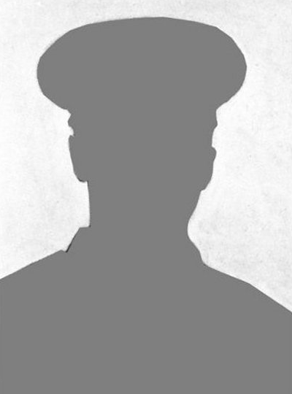
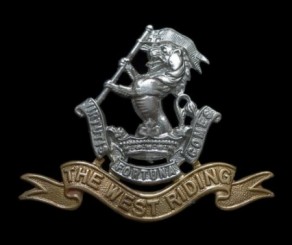


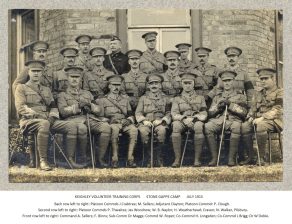
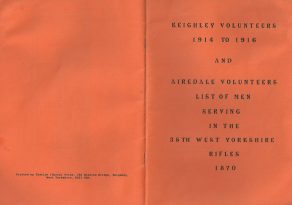

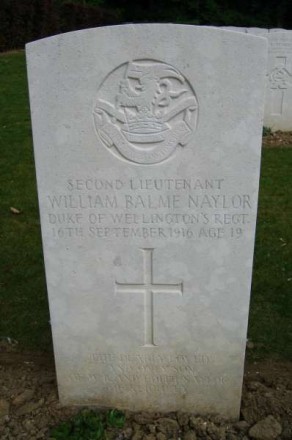

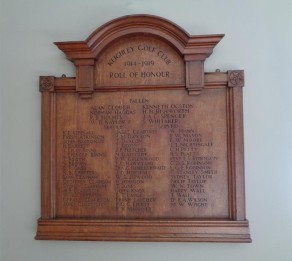




From the War Diary, 16th Sept. 2 Lieut W B Naylor was killed by shrapnel, in Leipzig Salient whilst acting as Bde Bomb Officer. Killed by Shrapnel wound in head.